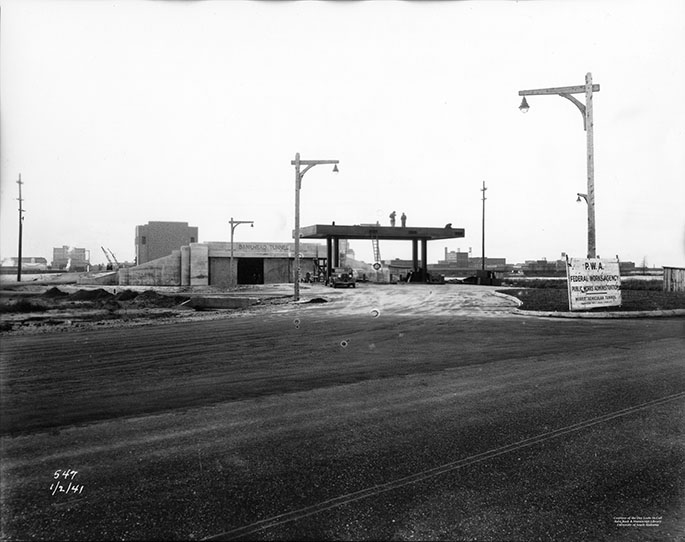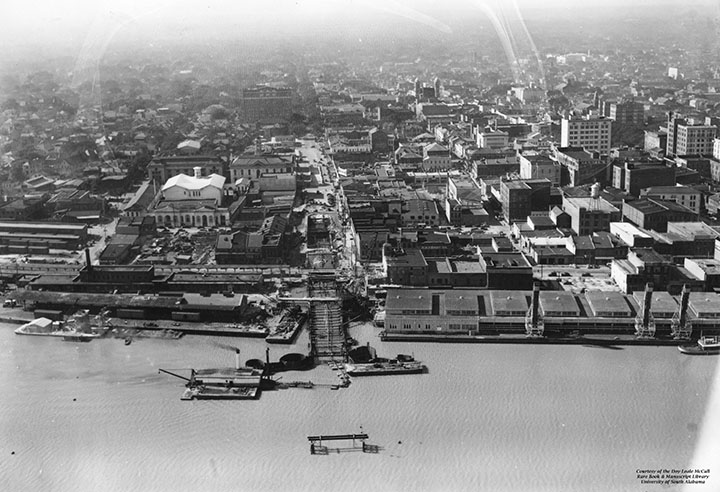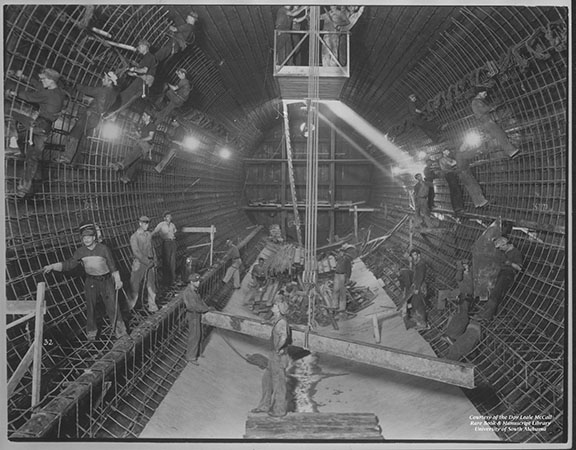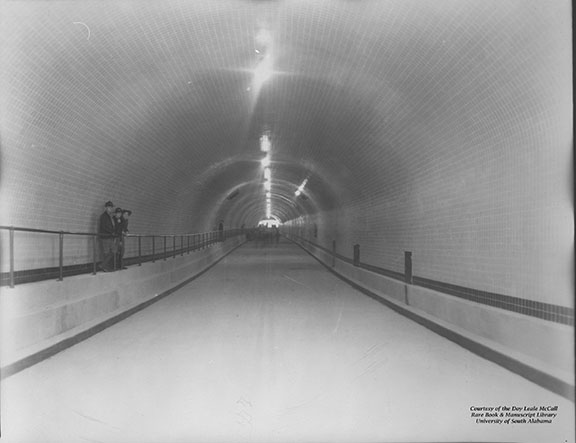The Bankhead Tunnel: Down the Bay and the New Deal
Posted on January 19, 2023 by Travis Cummins
Each day, around 14,000 vehicles use the Bankhead Tunnel to travel between Mobile and Baldwin. A vital link for commuters and cargo, the tunnel was one of many local New Deal projects that emerged nearly a century ago in response to the Great Depression. The 1930s ravaged Mobile, and lower-income communities like Down the Bay suffered the hardest. Between 1930 and 1940, hundreds of neighborhood workers suffered unemployment and the number of small businesses in the area declined by about 66%. US Census records put names to these larger trends. For example, when Mobile teachers went three months without pay, this placed a severe strain on the lives of educators living in the Down the Bay, such as Jessie Towle, a mother of two in her late thirties (Hinson 2001).
To address unemployment, the Roosevelt administration’s New Deal established the Works Progress Administration (WPA) in 1935. Hundreds of people from Down the Bay found much-needed work. The most common job for neighborhood women was making clothes and mattresses for the poor in WPA sewing houses. 49-year-old Mattie Vance lived in the northern part of the community. Census records reveal she lived with a husband who was unable to work and their two children and she spent 40 hours a week cutting fabric. Other women became cleaners, cooks, housekeepers, nurses, librarians, stenographers, and more.
 Bankhead Tunnel toll booth construction in 1941, a WPA project. Erik Overbey Collection,
The Doy Leale McCall Rare Book and Manuscript Library, University of South Alabama.
Bankhead Tunnel toll booth construction in 1941, a WPA project. Erik Overbey Collection,
The Doy Leale McCall Rare Book and Manuscript Library, University of South Alabama.
Men from the area worked on construction projects like the new federal courthouse on St. Joseph Street or the national guard armory at Fort Whiting. Others were employed in beautification efforts in parks such as Bienville Square. A few Down the Bay men were part of “Roosevelt’s Tree Army,” the name given to members of the Civilian Conservation Corps (CCC), an ambitious effort to protect the nation’s natural resources. The most common WPA job for African American men living in the neighborhood was improving dilapidated roads. Jerry Miller, who was in his early twenties and lived in the southern part of Down the Bay, spent his day laying bricks. 60-year-old Lum Welch dug ditches.
The census shows, however, that women and Black men were largely left out of New Deal job opportunities. In Ward 5, which largely comprised the eastern half of Down the Bay, over half of those involved in WPA projects were White men. The next largest group was White women, while the neighborhood saw only 13 Black men involved in WPA work. From the same census selection, just three Black women were employed through the New Deal.

Aerial photo of Mobile, with Down the Bay to the left, during the Bankhead Tunnel Construction. Erik Overbey Collection, The Doy Leale McCall Rare Book and Manuscript Library, University of South Alabama.
Several WPA jobs required Down the Bay residents work outside their neighborhood. However, the most common New Deal occupation for area workers from the area was a tunnel project right at the northern edge of their own community. Hinson writes that the Bankhead Tunnel, named after Senator John H. Bankhead, involved “pioneering marine engineering technology.” The $4-million-dollar project along highway 98 took two years to build. Dozens of men from the neighborhood worked to construct the 3,389-foot underwater tunnel, a rarity in the south at the time. They labored as pile drivers, river inspectors, carpenters, electricians, and steel or iron workers. 42-year-old Joseph LeFlore, a Mississippi native, worked as a night watchman for the project; Syrian migrant Pete Mahfouz, 46, worked as a carpenter’s helper. Though there were several tunnel workers from Ward 5, 35-year-old David Wright, a father of five, was the only African American working on the project.

Workers inside the interior tube of the Bankhead Tunnel. Taken in 1939 during tunnel construction. Erik Overbey Collection, The Doy Leale McCall Rare Book and Manuscript Library, University of South Alabama.
While the tunnel’s construction provided jobs for many Down the Bay residents, it undoubtedly changed life in other ways as well. Additionally, it was not the last transportation project to trigger major changes in the neighborhood. The Wallace Tunnel brought I-10 through the community in the 1970s and permanently transformed the lives of many residents. We hope to learn more about the impacts of these projects through our current research.

The interior of the Bankhead Tunnel in 1940, shortly after opening. Erik Overbey Collection, The Doy Leale McCall Rare Book and Manuscript Library, University of South Alabama.
This blog post was written by History Graduate student Travis Cummins as part of the I-10 Mobile River Bridge Archaeological Project. Travis gathered census data from Ward 5, which is primarily the area south of downtown Mobile and east of the I-10 corridor, and is considered the east part of Down the Bay. He identified trends in the census and connected individuals to the broader WPA effort in Mobile.
Sources:
1930 and 1940 U.S. Census Records
Billy Hinson, “Mobile During the Interwar Years,” in Mobile: The New History of Alabama’s First City (Tuscaloosa: The University of Alabama Press, 2001).


